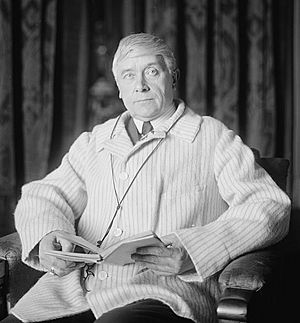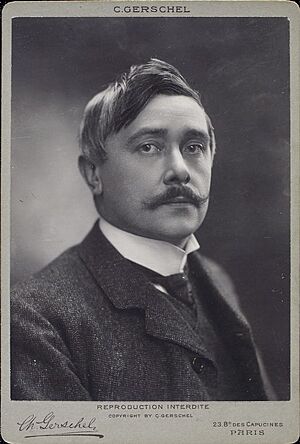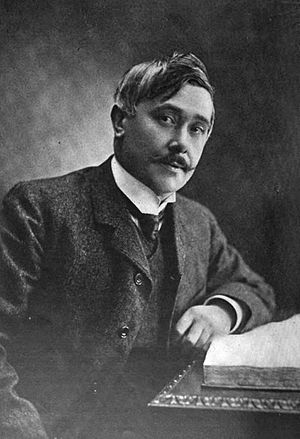Maurice Maeterlinck facts for kids
Quick facts for kids
Maurice Maeterlinck
|
|
|---|---|
 |
|
| Born | Maurice Polydore Marie Bernard Maeterlinck 29 August 1862 Ghent, Belgium |
| Died | 6 May 1949 (aged 86) Nice, France |
| Occupation | Playwright · Poet · Essayist |
| Language | French |
| Nationality | Belgian |
| Alma mater | University of Ghent |
| Literary movement | Symbolism |
| Notable works | Intruder (1890) The Blind (1890) Pelléas et Mélisande (1893) Interior (1895) The Blue Bird (1908) |
| Notable awards | Nobel Prize in Literature 1911 Triennial Prize for Dramatic Literature 1903 |
| Spouse | Renée Dahon |
| Partner | Georgette Leblanc |
| Signature | |
Maurice Maeterlinck (born August 29, 1862 – died May 6, 1949) was a famous Belgian writer. He was a playwright, poet, and essayist. Even though he was from the Flemish part of Belgium, he wrote all his works in French.
In 1911, he won the Nobel Prize in Literature. He received this award for his many literary works. His plays were especially praised for their imagination and poetic style. They often felt like fairy tales and inspired readers' feelings. Maeterlinck's main topics were life's meaning and death. He was a key figure in the Symbolist movement in art and literature. Later in his life, some people questioned if he had used ideas from others without giving full credit.
Contents
About Maurice Maeterlinck
Early Life and Education
Maurice Maeterlinck was born in Ghent, Belgium. His family was wealthy and spoke French. His mother, Mathilde, came from a rich family. His father, Polydore, was a notary who loved gardening.
In 1874, Maurice went to the Jesuit College of Sainte-Barbe. At this school, they did not like French Romantic writers. Only plays about religious topics were allowed. This experience made him dislike organized religion. One of his friends there was the writer Charles van Lerberghe. Their poems and plays influenced each other early in the Symbolist period.
Maeterlinck wrote poems and short stories while he was still a student. But his father wanted him to become a lawyer. After getting a law degree from the University of Ghent in 1885, he spent a few months in Paris, France. There, he met writers from the new Symbolist movement. Auguste Villiers de l'Isle-Adam greatly influenced Maeterlinck's later writing.
His Writing Career
Maeterlinck became well-known very quickly. This happened when his first play, Princess Maleine, received great praise in 1890. A famous literary critic, Octave Mirbeau, wrote about it in Le Figaro.
In the years that followed, Maeterlinck wrote many Symbolist plays. These plays often dealt with themes of fate and mystery. Some of his most important early plays include Intruder (1890), The Blind (1890), and Pelléas and Mélisande (1892).
From 1895 to 1918, he had a close relationship with the singer and actress Georgette Leblanc. She greatly influenced his work for two decades. With his play Aglavaine and Sélysette (1896), Maeterlinck started creating characters who had more control over their lives. Leblanc often played these strong female roles on stage. While mystery and deep ideas always influenced his work, Maeterlinck slowly moved from Symbolism to a more realistic style.
In 1895, Maeterlinck and Leblanc moved to Paris. They often hosted guests, including other famous writers. They spent their summers in Normandy. During this time, Maeterlinck published his Twelve Songs (1896) and The Treasure of the Humble (1896). He also wrote The Life of the Bee (1901) and Ariadne and Bluebeard (1902).
In 1903, the Belgian government gave Maeterlinck the Triennial Prize for Dramatic Literature. Around this time, and until World War I, he was seen as a very wise person across Europe. Many people looked up to him as a great thinker.
In 1906, Maeterlinck and Leblanc moved to a villa in the south of France. He spent his time thinking and walking. He wrote an essay called "The Intelligence of Flowers" (1906). In this essay, he showed support for socialist ideas. He also gave money to workers' unions and socialist groups. During this time, he created his most famous play, the fairy tale The Blue Bird (1908). This play is still performed today, often as a children's show. After writing "The Intelligence of Flowers," he felt sad and found it hard to write. He recovered after a year or two, but he never wrote with the same creativity again.
In 1910, he met Renée Dahon, an 18-year-old actress. She became his cheerful companion. In 1911, he received the Nobel Prize for Literature, which also made him feel better. By 1913, he openly supported socialist ideas. He sided with Belgian trade unions during a strike against the Catholic party. He also started studying mysticism and criticized the Catholic Church in his essays. Because of his writings, the Roman Catholic Church banned all his works in 1914.
When Germany invaded Belgium in 1914, Maeterlinck wanted to join the French army. But he was too old, so his request was denied. He and Leblanc moved to a villa near Nice, where he lived for the next ten years. He gave speeches praising the bravery of the Belgian people. He blamed all Germans for the war. While his strong feelings for his country were clear, his reputation as a wise person who stayed out of politics was affected by his political involvement.
While in Nice, he wrote The Mayor of Stilmonde (1918). American newspapers called it a "Great War Play." It was even made into a British film in 1929. He also wrote The Betrothal (1922), which was a follow-up to The Blue Bird.
On February 15, 1919, Maeterlinck married Dahon. He was invited to the United States, where a film producer named Samuel Goldwyn asked him to write movie ideas. Maeterlinck wrote some ideas, including one about his book The Life of the Bee. But Goldwyn did not use any of his ideas. When Goldwyn read the bee story, he reportedly exclaimed, "My God! The hero is a bee!"
After 1920, Maeterlinck did not write much for the theater. But he continued to write essays about his favorite topics. These included hidden knowledge, ethics, and nature. Demand for these essays decreased after the early 1920s. However, his books still sold well in France until the late 1930s.
Later Life and Death
In 1930, Maeterlinck bought a large house (a château) in Nice, France. He named it Orlamonde, a name from one of his own works.
In 1932, King Albert I of the Belgians made him a count. However, Maeterlinck did not complete the paperwork, so the title was never officially used.
In 1940, Maeterlinck traveled to the United States from Lisbon. He had fled to Lisbon to escape the Nazi invasion of Belgium and France. He told The New York Times that he believed he would have been shot by the Germans because of his play, The Mayor of Stilmonde. This play was about life in Belgium during the German occupation in 1918. He found Americans too informal and friendly for his liking.
He returned to Nice after the war in 1947. He was the president of PEN International, a worldwide group of writers, from 1947 to 1949. In 1948, the French Academy gave him a medal for his contributions to the French language. Maurice Maeterlinck died in Nice on May 6, 1949, after having a heart attack.
Honors and Awards
- 1920: He received the Grand Cordon of the Order of Leopold.
- 1932: He was named Count Maeterlinck by the King of Belgium.
Static Drama: Plays with Puppets
Maeterlinck is remembered for his early plays, written between 1889 and 1894. These plays had a new style of dialogue. The words were very simple and direct. What was hinted at was often more important than what was actually said. The characters in these plays did not know what would happen next. They also had little understanding of themselves or the world around them.
Maeterlinck believed that real actors could not properly show the symbolic ideas in his plays. He thought that their physical movements and expressions got in the way. So, he decided that marionettes (puppets on strings) were a better choice. He felt that marionettes, controlled by a puppeteer, perfectly showed how fate controls people. He wrote plays like Interior, The Death of Tintagiles, and Alladine and Palomides for puppet theater.
From this idea, he developed his concept of "static drama." He believed that artists should create works that show the outside forces that control people, rather than just human emotions. Maeterlinck once wrote that "poems die when living people get into them."
He explained his ideas about static drama in his essay "The Tragic in Daily Life" (1896). This essay was part of his book The Treasure of the Humble. In static drama, actors were supposed to speak and move as if an outside force, like fate, was pushing and pulling them. They should not let their inner feelings control their movements. Maeterlinck often called his characters "marionettes."
He pointed to old Greek tragedies as examples of static drama. He argued that these plays were almost motionless. They focused on the individual facing the universe, rather than on a lot of action.
Maeterlinck's Influence on Music
Maeterlinck's play Pelléas and Mélisande inspired many musical works around the year 1900:
- 1897: An orchestral suite by William Wallace.
- 1898: An orchestral suite by Gabriel Fauré.
- 1893–1902: An opera by Claude Debussy.
- 1902–1903: A symphonic poem by Arnold Schoenberg.
- 1905: Incidental music by Jean Sibelius.
Other musical works based on Maeterlinck's plays include:
- Aglavaine and Sélysette
- orchestral prelude by Arthur Honegger
- Aladina and Palomid
- opera by Burghauser
- Ariane et Barbe-bleue
- opera in 3 acts by Paul Dukas
- The Betrothal
- incidental music by Armstrong Gibbs
- The Blind
- opera by Beat Furrer
- The Death of Tintagiles
- symphonic poem by Charles Martin Loeffler
- Herzgewächse (Foliages of the Heart)
- Lied for soprano by Arnold Schoenberg
- Monna Vanna
- opera in 3 acts by Emil Ábrányi
- Monna Vanna, opera in 4 acts by Henry Février
- L'oiseau bleu (The Blue Bird)
- opera by Albert Wolff
- Princess Maleine
- overture by Pierre de Bréville
- The Seven Princesses
- incidental music by Pierre de Bréville
- Sœur Beatrice
- opera by Alexander Grechaninov
- Intérieur
- opera by Giedrius Kuprevičius
Works by Maurice Maeterlinck
Poetry Collections
- Serres chaudes (1889)
- Douze chansons (1896)
- Quinze chansons (1900)
Plays (Drama)
- La Princesse Maleine (Princess Maleine) (1889)
- L'Intruse (Intruder) (1890)
- Les Aveugles (The Blind) (1890)
- Les Sept Princesses (The Seven Princesses) (1891)
- Pelléas and Mélisande (1892)
- Alladine et Palomides (1894)
- Intérieur (Interior) (1894)
- La Mort de Tintagiles (The Death of Tintagiles) (1894)
- Aglavaine et Sélysette (1896)
- Ariane et Barbe-bleue (Ariane and Bluebeard) (1899)
- Soeur Béatrice (Sister Beatrice) (1901)
- Monna Vanna (1902)
- Joyzelle (1903)
- Le Miracle de saint Antoine (The Miracle of Saint Antony) (1904)
- L'Oiseau bleu (The Blue Bird) (1908)
- Marie-Magdeleine (Mary Magdalene) (1910)
- Le Bourgmestre de Stilmonde (1919)
- Les Fiançailles (1922)
- Le Malheur passe (1925)
- La Puissance des morts (1926)
- Berniquel (1926)
- Marie-Victoire (1927)
- Judas de Kerioth (1929)
- La Princess Isabelle (1935)
- Jeanne d'Arc (Joan of Arc) (1948)
Essays
- Le Trésor des humbles (The Treasure of the Humble) (1896)
- La sagesse et la destinée (Wisdom and Destiny) (1898)
- La Vie des abeilles (The Life of the Bee) (1901)
- Le temple enseveli (The Buried Temple) (1902)
- Le Double Jardin (The Double Garden) (1904)
- L'Intelligence des fleurs (The Intelligence of Flowers) (1907)
- La Mort (Our Eternity) (1913)
- L'Hôte inconnu (1917)
- Le grand secret (The Great Secret) (1921)
- La Vie des termites (The Life of Termites) (1926)
- La Vie de l'espace (The Life of Space) (1928)
- La Grande Féerie (1929)
- La Vie des fourmis (The Life of the Ant) (1930)
- L'Araignée de verre (1932)
- Avant le grand silence (Before the Great Silence) (1934)
- L'Ombre des ailes (The Shadow of Wings) (1936)
- Devant Dieu (1937)
- La Grande Porte (1938)
- L'Autre Monde ou le cadran stellaire (The Other World, or The Star System) (1941)
Memoirs
- Bulles bleues (1948)
See also
 In Spanish: Maurice Maeterlinck para niños
In Spanish: Maurice Maeterlinck para niños






